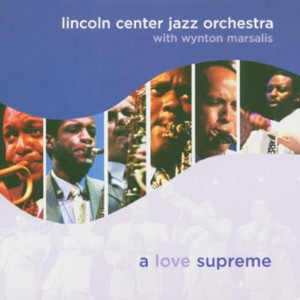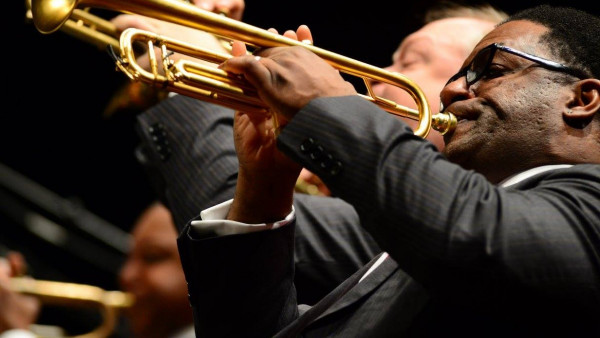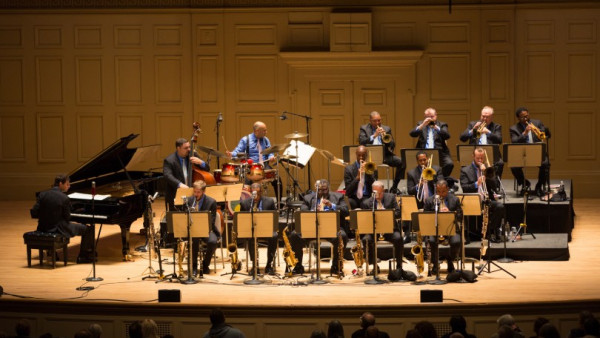A Love Supreme
In 1964 John Coltrane recorded A Love Supreme with McCoy Tyner, Jimmy Garrison, and Elvin Jones. It’s one of most influential and imposing jazz suites ever written, and on this debut CD for the Palmetto label, The Lincoln Center Jazz Orchestra, featuring Wynton Marsalis, adapts Coltrane’s immortal composition to the big band. Not to be outdone by his brother Branford’s quartet version of this material recorded live on DVD, Wynton and company skillfully extend and elaborate on the Coltrane’s work, and preserve the soul-searching spirit of the four-part suite, which deals with the blues, 4/4 swing, Afro-Latin rhythms, and ballads. Pulsed by Carlos Henriquez’s sure-footed basslines, Herlin Riley’s spiritual syncopations and Eric Lewis’s profound pianisms, saxophonist Wess “Warmdaddy” Anderson’s Tranish cries, and the leader’s triumphant trumpet tones are as fluent and fierce as ever. Collectively, this brilliant orchestra goes where no large ensemble has gone before.

Album Info
| Ensemble | JLCO with Wynton Marsalis |
|---|---|
| Release Date | January 11th, 2005 |
| Recording Date | August 26, 2003 |
| Record Label | Palmetto Records |
| Catalogue Number | PM 2106 |
| Formats | CD, Digital Download |
| Genre | Jazz at Lincoln Center Recordings |
Track Listing
| Track | Length | Preview |
|---|---|---|
| Acknowledgement | 11:24 | Play |
| Resolution | 9:40 | Play |
| Pursuance | 8:29 | Play |
| Psalm | 12:07 | Play |
Liner Notes
This new version of A Love Supreme is the first example of Wynton Marsalis’s intention to bring the music of John Coltrane into the repertoire of the Lincoln Center Jazz Orchestra, which inarguably performs the largest repertoire of jazz material in the world, stretching from the work of Jelly Roll Morton to that of Ornette Coleman. Marsalis intends to follow this recording with personal and commissioned big band arrangements of the Coltrane music on Crescent, Coltrane Plays the Blues, Giant Steps, and Transition. “That will give us some challenges,” says Marsalis, “and it makes that music new because no one has put it into a big band context, which is another place that it belongs. All great music should be played in as many contexts as possible. That is one of the reasons that we have the Lincoln Center Jazz Orchestra.”
The Orchestra began to announce its importance at its very first performance, which was a 1988 Lincoln Center summer festival then called “Classical Jazz.” It was an evening of Ellington music that surprised all who came to hear it because they did not get what had become a customary presentation of Ellington, which tended to be a string of his most popular songs and instrumental compositions. That evening the audience was treated to “Such Sweet Thunder” “Suite Thursday” and “Anatomy of A Murder” – all transcendent pieces of late Ellington.
The concert had revolutionary impact because selections of the largely neglected music of a sequoia of jazz were presented as if played for the first time. Even Ellington fans had not heard that music performed in the flesh and a new direction for jazz was opened on that night. No longer did jazz listeners have to be satisfied with recorded performances once the musicians had died. Since then, the Lincoln Center Jazz Orchestra has continued to present the music of jazz masters, commissioned works, and collaborated with musicians from all over the world.
“We are after finding out the meaning of jazz and how many ways we can meet the demands and essentials of blues and swing, “Marsalis says. “We have swung the music in every jazz style, from New Orleans to Ornette Coleman and John Coltrane, Joe Henderson and Wayne Shorter, the last two presented in commissioned new works. We have played the blues in every style. We have played the ballad or contemplative jazz music in every style. We have maintained an investigation and expansion of Latin rhythms, and rhythms from all over the world, as jazz musicians have always done. Jazz added a lot to the music of the world and part of our mission is to show just how broad the beauty of jazz is. We believe that all jazz is modern, and all our efforts are devoted to that principle.”
A Love Supreme is, obviously, one of the most influential and revered of jazz recordings. At that point in his career, John Coltrane was immersed in moving from the macro of harmonic complexity to the micro of harmonic simplicity. But his greatest contributions were made in his additions of new ways to address the essentials of jazz: his band had achieved fresh interpretations of 4/4 swing, of ballad materials, of the blues, and of Afro-Latin grooves. Most of his innovations were not in what was written, but in how his band played. His greatest importance and influence came through the extraordinary improvising of a saxophonist, a pianist (McCoy Tyner), a bassist (Jimmy Garrison), and a drummer (Elvin Jones). Coltrane’s music was in his and his ensemble’s playing, and he could not have achieved what he did without musicians of any less originality and intensity than those in what is now called the classic John Coltrane Quartet. “The point of what John Coltrane was doing in A Love Supreme was finding out how much he could do with a very small amount of material. So the challenge of writing for a big band is to figure out how all of that music comes together and how to build upon its fundamental ideas,” says Marsalis. “The first thing is that he has a cyclical form, which begins in the universal church and ends in the church of Negro spirituals. The first movement relates to influences from as far away as Japan in the flute parts. It builds on the unity of the minor third and the fourth, which is a kernel of the pentatonic scale that runs through all the music around the world. Coltrane was aware of this, I’m sure. The first movement ends with the congregation saying “A Love Supreme” individually from the low baritone saxophone to the piccolo. The clarinet threads this together with the pentatonic scale of each statement, which is in different tonal center. So the clarinet adjusts to each change.”
The second and third movements speak for themselves, and each features explosive improvisations from either Wess Anderson or Marsalis, as well as virtuosic heat and authority from the brass and reed sections, all riding on the stoked up groove of Carlos Henriquez and the incomparable Herlin Riley. By the last movement, “We are back in the church.” Marsalis chose to build his arrangement on Coltrane’s solo, which became, as with all the best jazz improvisation, a composition the moment it was released on record. A stunning conclusion is reached as this grand statement is not improved by any means, but enlarged to meet the ambitions and standards of our greatest jazz big band. Nothing can every replace the original, but as this recording proves, even things we think we know all about can be extended into areas beyond our imagination. In essence, that is surely part of the meaning and one of the great satisfactions of jazz.
—Stanley Crouch © 2004
Credits
Produced by Delfeayo Marsalis
Executive Producers: Wynton Marsalis and André Kimo Stone Guess for Jazz at Lincoln Center
Recorded and mixed by Patrick Smith
Assistant Engineer: Jason Stasium
Recorded at Right Track Studio A509 on August 26, 2003
Mixed at Glenwood Place Studios. Burbank, CA
Mastered by Daryl Dickerson at Artistic Studios, New Orleans, LA
Production Coordinator: Derek Kwan / Jazz at Lincoln Center
To obtain more wood sound from the bass, this CD was recorded without use of the dreaded bass direct.
All Photography: Frank Stewart / Jazz at Lincoln Center
Art Direction, Design, Illustration: Keith Henry Brown / Jazz at Lincoln Center
Image of John Coltrane from a photograph by Chuck Stewart
Special Thanks to:
Lisa Schiff, Chairman; Wynton Marsalis, Artistic Director; Hughlyn F. Fierce, President & CEO; Derek E. Gordon, Executive Director and the board and staff of Jazz at Lincoln Center
Jazz at Lincoln Center
33 West 60th Street
New York, NY 10023
www.jalc.org
WWW.PALMETTO-RECORDS.COM
visit our website to view our entire catalogue and for free downloads
Personnel
- Lew Soloff – trumpet
- Marcus Printup – trumpet
- Ryan Kisor – trumpet
- Ron Westray – trombone
- Vincent Gardner – trombone
- Andre Hayward – trombone
- Victor Goines – tenor sax, soprano sax, clarinet, bass clarinet
- Ted Nash – alto sax, soprano sax, clarinet, flute, piccolo
- Wess “Warmdaddy” Anderson – alto sax, sopranino sax
- Walter Blanding – tenor sax, soprano sax, clarinet
- Joe Temperley – baritone sax, bass clarinet
- Eric Lewis – piano
- Carlos Henriquez – bass
- Herlin Riley – drums, tambourine
Also of Interest
-
 Photo Galleries
Photo Galleries
JLCO with Wynton Marsalis playing the music of John Coltrane at Alice Tully Hall, New York
-
 News
News
A Love Supreme: JLCO plays Coltrane at Boston Symphony Hall
-
 News
News
Orchestra Pays Tribute to John Coltrane at Symphony Hall
-
 News
News
A love Supreme, the new Wynton Marsalis and JLCO’s album, is out !
-
 News
News
Lincoln Center Jazz Orchestra Featuring Wynton Marsalis: A Love Supreme (2005)
-
 News
News
Palmetto Records is new label for LCJO with Wynton Marsalis
